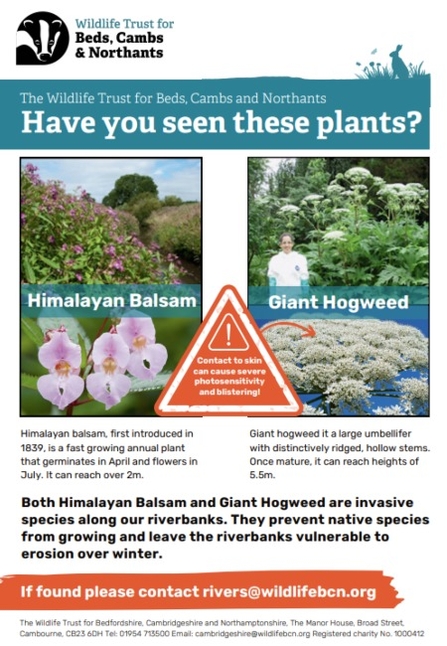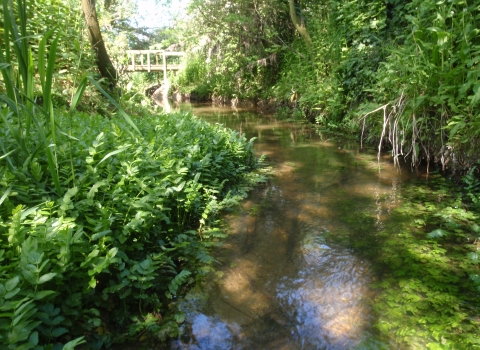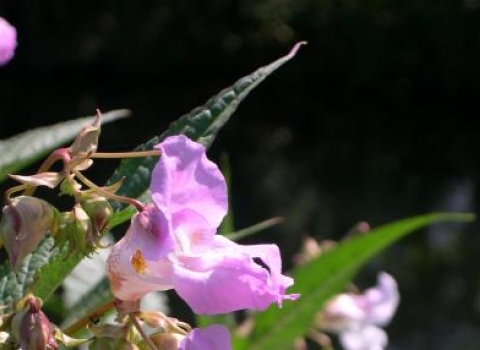Bourn Brook flows from Caxton in Cambridgeshire down to Byron's Pool in Granchester, where it joins the River Cam. Most of the brook is within our West Cambridgeshire Hundreds Project area.
Results of our 2019 water vole and invasive plants survey are available here.
Volunteer efforts to control Himalayan balsam are definitely starting to pay off and we are back in 2024. See the volunteer workparty dates below and please do come out and help.
2024 work party dates:
| Date | Location | Public? | Who |
|---|---|---|---|
| 02/07/24 | Barton | No | CRT |
| 04/07/24 | Bourn + Eversden | No | WTBCN |
| 07/07/24 | Caldecote | Public | CCV |
| 07/07/24 | Toft village |
Public |
Toft Friends of Bourn Brook |
| 11/07/24 | Barton | No | CRT |
| 13/07/24 | Barton | Public | CRT* |
| 14/07/24 | Kingston Old Railway | Public | CCV |
| 18/07/24 | Barton | No | CRT |
| 21/07/24 | Byron's Pool | Public | CVF |
| 21/07/24 | Toft meridian |
Public |
CCV** |
| 24/07/24 | Bourn + Eversden | No | WTBCN |
| 28/07/24 | Comberton | Public | CCV |
| 03/08/24 | Barton | Public | CRT* |
| 04/08/24 | Caldecote | Public | CCV |
*Dates may change to 20/07 and 10/08. Choice of location depends on effectiveness of previous corporate groups. **Date may change to 28/07. ***There will be a couple of early morning golf course tasks TBC. Contact WTBCN.
Please contact the task leader beforehand for meeting point details:
- CRT = Countryside Regeneration Trust
- Contact: Vince Lea, 01223 263962, 07716 826972, vincelea@btinternet.com
- CCV = Cambridge Conservation Volunteers
- Contact: Vince Lea, 01223 263962, 07716 826972, vincelea@btinternet.com
- Toft Friends of Bourn Brook
- Contact: Toft - Bourn Brook
- CVF = Cam Valley Forum
- Contact: Bourn Brook Balsam Bash - Eventbrite
- WTBCN = Wildlife Trust BCN
- Contact: Ruth Hawksley, 01954 713533, 07545 423854, ruth.hawksley@wildlifebcn.org
If you experience any challenges contacting the task leaders please contact Ruth Hawksley, ruth.hawksley@wildlifebcn.org.

About the Bourn Brook
Invasive species such as giant hogweed and Himalayan balsam have a bad effect on the brook. Both form dense stands which shade out native plants (which, in turn are better for native insects), and both die back in winter leaving bare banks vulnerable to erosion. A small army of volunteers attacks the balsam every year. You can read a local's view of our 2015 balsam campaign here.
Bourn brook is a valuable habitat for water voles - arguably the UK’s fastest declining mammal. Loss and fragmentation of habitat are largely to blame, followed more recently by predation by American mink. Water voles have few defences against this non-native animal which can decimate their populations. We've been monitoring and controlling the mink and we've also been creating ideal water vole habitat: with lush vegetation for food and shelter, soft banks at around 45 degrees for digging burrows, and water at least 30cm deep.
In 2011, five out of 11 sections of the brook had signs of water voles. Since then the project has helped to control mink and in 2014 eight of 11 sections had signs of water vole, and overall numbers of signs had increased. By 2017 water vole signs were present all along the brook, as a continuous population.
Eventually we hope through this project to achieve much more along the brook, including improving water quality and improving habitat in and adjacent to the watercourse. The aim is to have a properly functioning wetland ecosystem, an abundance of wildlife and storage of floodwater on flood meadows rather than exporting it downstream. Being a 'wildlife corridor', work on the length of the brook will have a greater impact than the sum of each individual's actions.
The project newsletter can be downloaded at the bottom of the page.
Identifying species
More information on invasive species, and ID sheets to download
To learn how to recognise water vole signs, download our ID guide.
Contact Ruth Hawksley for more information at ruth.hawksley@wildlifebcn.org or 01954 713533.


